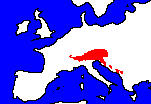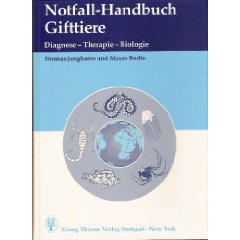|


| |
Salamandra
atra, Alpensalamander


Beschreibung: Der Alpensalamander
erreicht eine Länge bis zu 15 cm. Sie sind lackschwarz gefärbt. Deutlich
erkennbar sind die Parotiden (Ohrspeicheldrüsen). Aus diesen können die Tiere
ein toxisches Sekret absondern. Bei extremen Stress kann das Toxin aus den
Drüsen über einen Meter in dünnen Strahlen herausgespritzt werden.
Unterarten:
Vorkommen: Die Tiere kommen in den Gebirgen des Balkans und in den
Alpen vor. Almwiesen und feuchte Mischwälder aus Laubbäumen sind die am meisten
bewohnten Lebensräume.

Toxine: In einem Alpensalamander sind 4 bis 5 mg der
Steroid-Alkaloide (Samandarin
und Samandirin) enthalten. Samandirin wirkt krampfauslösend.
Symptomatik: Auf der Haut und der Schleimhaut können die Sekrete
der Drüsen Reizungen verursachen. Die Nervengifte können Krämpfe und
Atemstörungen auslösen. Ernste Vergiftungen beim Menschen sind nicht bekannt.
Maßnahmen: Betroffene Hautstellen sind gründlich mit Wasser
auszuspülen. Bei einer Einwirkung auf das Auge ist das Auge sorgfältig zu
spülen. Falls der Patient Kontaktlinsen trägt sind diese zu
entfernen. Nun kann das Auge nach Bedarf
anästhesiert werden. Ein
schmerzfreier Patient kann seine Augen dann oft auch selbst öffnen. Nun erfolgt
die Spülung. Man spült immer von innen nach außen, d.h. von der Nase in Richtung
Wange. Die Spülung sollte mit mindestens 10 Litern Wasser erfolgen. Da diese
Mengen im Rettungsdienst nicht vorrätig sind, muss man eben nehmen was man hat.
Eine klinische Abklärung durch einen Augenarzt muss auf jeden Fall erfolgen.
Bei auftretenden Krämpfen können die Benzodiazepine
Midazolam
oder
Diazepam eingesetzt werden. Alle weiteren Maßnahmen erfolgen symptomatisch.
Literatur:
-

-
- Alpensalamander –
Wikipedia
-
Toxikologische Abteilung, Klinikum Rechts der Isar, München
-
Genetic variation in an endemic salamander, Salamandra atra, using amplified
fragment length polymorphism.
-
Der Alpensalamander (Salamandra atra)
-
Phylogeography of the Alpine salamander, Salamandra atra (Salamandridae) and
the influence of the Pleistocene climatic oscillations on population
divergence.
-
Mitochondrial sequence analysis of Salamandra taxa suggests old splits of
major lineages and postglacial recolonizations of central Europe from distinct
source populations of Salamandra salamandra.
-
Survey of the oviduct of salamandrids with special reference to the viviparous
species.
-
Pigmentary system of the adult alpine salamander Salamandra atra atra (Laur.,
1768).
-
Pigmentary system of the adult alpine salamander Salamandra atra aurorae (Trevisan,
1982).
-
Epitheliophagy- intrauterine cell nourishment in the viviparous alpine
salamander, Salamandra atra (Laur.).
-
Comparative ultrastructural investigations of the uterine epithelium in the
viviparous Salamandra atra Laur. and the ovoviviparous Salamandra salamandra
(l.) (amphibia, urodela).
-
Reproductive biology of the alpine salamander (Salamandra atra Laur)]
-
Histology of the oviduct in mature Salamandra atra, a completely viviparous
urodele at high altitude]
-
Preliminary research on cutaneous venom of Salamandra atra]
-
Observations on the nucleic acids during the development of the lethal hybrid
Triton palmatus male chi Salamandra atra female.
-
Alpensalamander,
Salamandra atra
-
Alpensalamander - Salamandra atra (LAURENTI, 1768)
-
AmphibiaWeb - Salamandra atra
-
Amphibien Alpensalamander
Salamandra atra
-
Salamanderseiten
|